|
Notes: Rayne Station was on the down side of the line with substantial
brick buildings comprising station masters house, booking office,
waiting room, porters room, lamp room and toilets. Initially the station didn't handle goods traffic but by the turn of the 20th century a small yard had opened accessed from a shunting spur. In the early years of the 20th century the yards was expanded with an additional siding running through a large brick goods shed. A shunting
spur gave access to the goods yard with a goods shed. The yard handled a full range of goods traffic
and had a cattle dock and coal yard. There was a signal box on
the up side of the line; this was provided when the goods yard first opened..
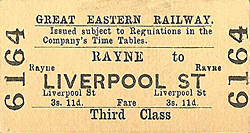 Rayne Station was restored in 1994 and converted to a visitor centre with toilets a small exhibition and the working base for the Essex County Park Rangers
who maintain the Flitch
Way. In 2006 the Rangers moved to Takeley station and early in 2007 the office was converted into a tearoom opening at weekends from 11am to 4pm serving hot and cold drinks and snacks. In 2009 the tearoom was taken over by Rob Branch and is open every day and is now a very popular meeting place for visitors to the Flitch Way. For more information about the Booking Hall cafe visit their website. A Scout hall now occupies the far end of the site where the
goods yard was. Rayne Station was restored in 1994 and converted to a visitor centre with toilets a small exhibition and the working base for the Essex County Park Rangers
who maintain the Flitch
Way. In 2006 the Rangers moved to Takeley station and early in 2007 the office was converted into a tearoom opening at weekends from 11am to 4pm serving hot and cold drinks and snacks. In 2009 the tearoom was taken over by Rob Branch and is open every day and is now a very popular meeting place for visitors to the Flitch Way. For more information about the Booking Hall cafe visit their website. A Scout hall now occupies the far end of the site where the
goods yard was.
In August 2013 The Friends of the Flitch Way submitted a planning application to Braintree District Council for the siting of a railway carriage on rails at Rayne station for use as a general education display area and museum. The application was approved subject to conditions. In October a short length of track was laid and the carriage arrived on 16 October and it s now being fitted out ready for opening in 2014. See The Railway Carriage Project on the Friends of Flitch Way web site.
Click here to see 'Can't find me' the official video by Next of Kin which was filmed at Rayne station. Next of Kin are a harmony trio from Braintree who had a No 13 hit single in 1999 and appeared on X Factor in 2013.
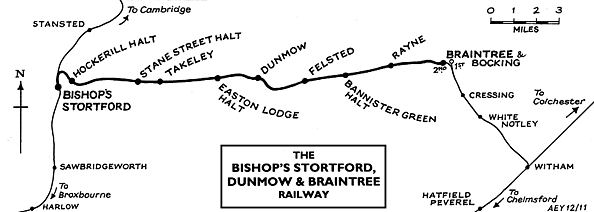
BRIEF HISTORY OF THE BISHOPS STORTFORD TO BRAINTREE LINE
By 1860 most of the rail network was in place, leaving
only the gaps between main line stations to be filled. Central
and West Essex, a predominantly rural area, had been largely ignored
during the initial development because it wasn't considered a
viable proposition.
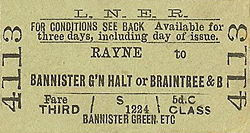 In 1859 an unexpected proposal was submitted to Eastern Counties
Railway by a group of Hertfordshire businessmen who were anxious
to obtain easy transport for malt and barley from towns and villages
in West Essex. Their proposal was for a railway line, 18 miles long, linking
the towns of Bishop's Stortford, Dunmow and Braintree. They readily
agreed to the proposal, offering to have the route surveyed and
donating £40,000 to help with construction. The application
was put to parliament and permission was given for the branch
line to go ahead. In 1859 an unexpected proposal was submitted to Eastern Counties
Railway by a group of Hertfordshire businessmen who were anxious
to obtain easy transport for malt and barley from towns and villages
in West Essex. Their proposal was for a railway line, 18 miles long, linking
the towns of Bishop's Stortford, Dunmow and Braintree. They readily
agreed to the proposal, offering to have the route surveyed and
donating £40,000 to help with construction. The application
was put to parliament and permission was given for the branch
line to go ahead.
In 1862 the ECR was amalgamated with the Great Eastern Railway
(GER) but directors were adamant they would continue with the
branch line. Despite poor local backing and the shortfall in subscriptions,
the GER decided to fully finance the line themselves and absorb
all of the shares of the local company.
The first turf was ceremonially cut at Dunmow on the 24 February
1864 and contractors began work the following. Virtually the entire
length of the branch line's 18 mile route was single track, except
at Dunmow and one or two other stations where dual track allowed
trains to pass each other. The line was finally opened for passenger
use on 22 February 1869.
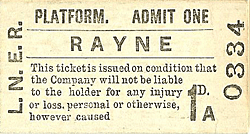 With hindsight, it is now apparent that the branch line was never
going to succeed as a profit making passenger service. The branch
line's saviour came in the 1880s. The sudden demand for agricultural
produce in London combined with new industries that were starting
up in Braintree, both required a freight service and it was this
that was to provide important revenue for the railway. Freight
traffic continued to grow, especially at the Braintree end of
the line, but by the end of the 19th century passenger traffic
to Bishop's Stortford remained light. With hindsight, it is now apparent that the branch line was never
going to succeed as a profit making passenger service. The branch
line's saviour came in the 1880s. The sudden demand for agricultural
produce in London combined with new industries that were starting
up in Braintree, both required a freight service and it was this
that was to provide important revenue for the railway. Freight
traffic continued to grow, especially at the Braintree end of
the line, but by the end of the 19th century passenger traffic
to Bishop's Stortford remained light.
When the GER finally amalgamated with the London & North
Eastern Railway (LNER) on 1 January 1923, the new company made
every effort to increase passenger traffic on the branch line
by doubling the initial three passenger trains a day running in
each direction, to six. But all to no avail. It was still the
carriage of freight that supplied the revenue.
During the Second World War the line was used to transport thousands
of tons of rubble for the construction of Saling airfield, 5 miles
from Braintree and, later, when it became operational, massive
loads of bombs were carried to the same destination under cover
of darkness. The United States Air Force bases at Stansted and
Easton Lodge were also regularly supplied with armaments and stores
arriving via Bishop's Stortford and Takeley station. After the
invasion of Europe in June 1944 the line was used by ambulance
trains to bring back wounded soldiers.
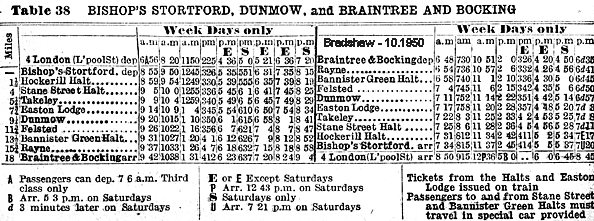
After the war the public's use of motor cars and competition
from bus transport increased, the passenger service between Bishop's
Stortford and Braintree ran virtually empty and inevitably, closure
of the line for passenger traffic was announced. Despite public
protests, the last train to run between the two towns was on 1
March 1952.
Despite the loss of the passenger service after 83 years the
line was kept open for freight traffic, which was still an important
source of revenue. But by 1968 more and more freight was being
transported by road and the branch line now became uneconomical
to keep open.
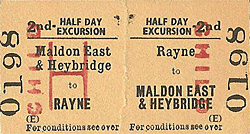 By the end of 1971 all freight traffic had ceased, and on 27
July 1972 a final enthusiast's trip ran from Bishop's Stortford
to Easton Lodge and back. By the autumn of that year most of the
track had been taken up, apart from the last mile out of Bishop's
Stortford. British Rail were considering the possible role this
section of line might play in carrying additional traffic to a
growing Stansted Airport, but proposals came to nothing and in
1974 the remaining track was removed. By the end of 1971 all freight traffic had ceased, and on 27
July 1972 a final enthusiast's trip ran from Bishop's Stortford
to Easton Lodge and back. By the autumn of that year most of the
track had been taken up, apart from the last mile out of Bishop's
Stortford. British Rail were considering the possible role this
section of line might play in carrying additional traffic to a
growing Stansted Airport, but proposals came to nothing and in
1974 the remaining track was removed.
Much of the old track bed now forms the Flitch
Way a walking and cycling path from Braintree to Bishops Stortford
along the 15 mile course of the Bishops Stortford, Dunmow &
Braintree Railway line.
Tickets from Michael Stewart, Route map drawn by Alan Young, Bradshaw from Nick Catford
Sources:
Other web sites: Railways
of Essex & Branching
Out
To see the other
stations on the Bishops Stortford - Braintree branch click on
the station name: Hockerill
Halt, Stane
Street Halt, Takeley,
Easton Lodge, Dunmow,
Felsted & Bannister
Green Halt |

old2.jpg) Rayne station staff pose for the photographer c1907. William Veitch is seen on the left. He was employed by the GER as a a relief booking clerk which entailed travelling to various stations to work wherever his services were required.
Rayne station staff pose for the photographer c1907. William Veitch is seen on the left. He was employed by the GER as a a relief booking clerk which entailed travelling to various stations to work wherever his services were required.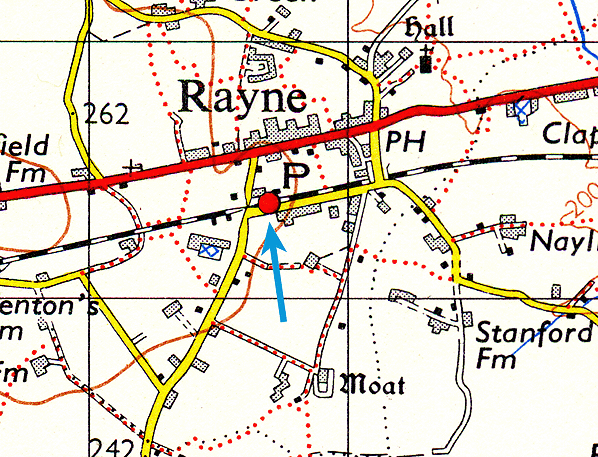
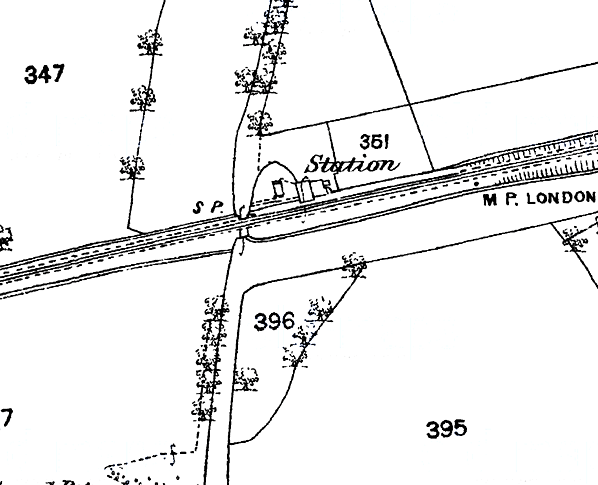
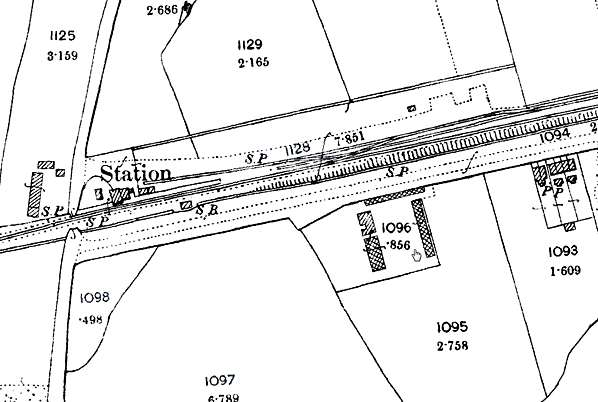
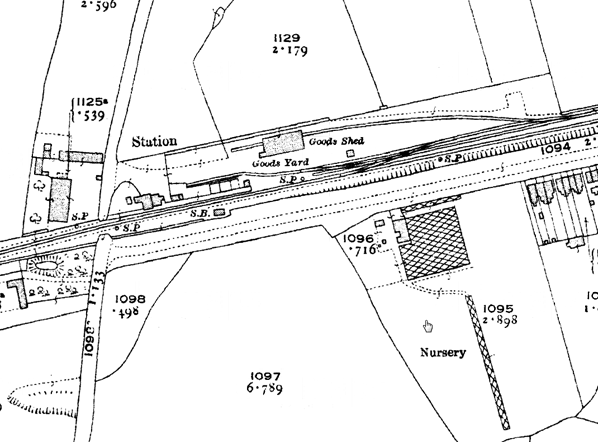
old3.jpg) A mixed goods train is approaching Rayne station c1910. The large brick goods shed can be seen to the left of the train. At this time the station staff took pride in the appearance of the station A number of barrows and trolleys are seen on the well kept platform.
A mixed goods train is approaching Rayne station c1910. The large brick goods shed can be seen to the left of the train. At this time the station staff took pride in the appearance of the station A number of barrows and trolleys are seen on the well kept platform.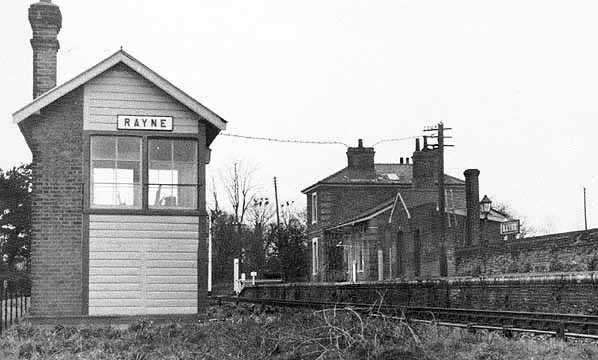 Rayne station and signal box looking west c1950s
Rayne station and signal box looking west c1950s old6.jpg) Rayne station forecourt in June 1968
Rayne station forecourt in June 1968 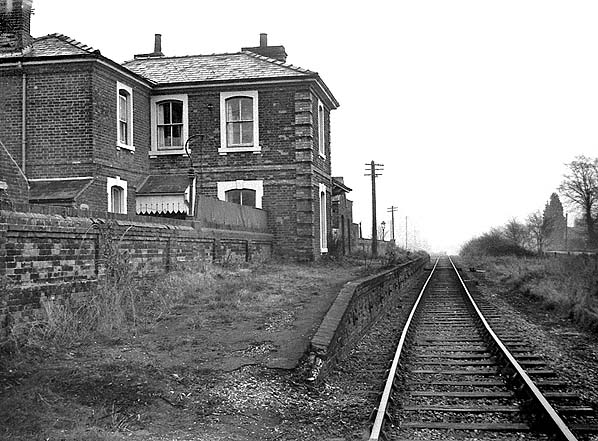
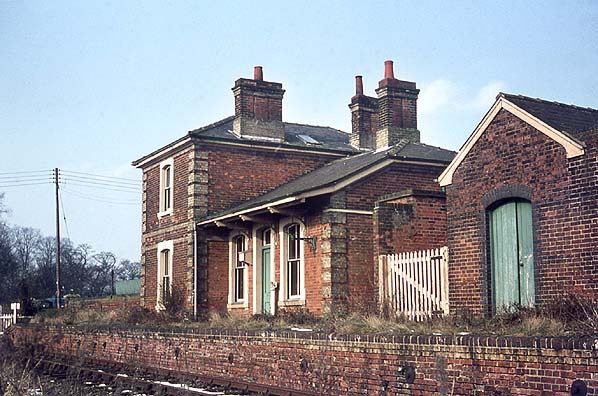
30.jpg)
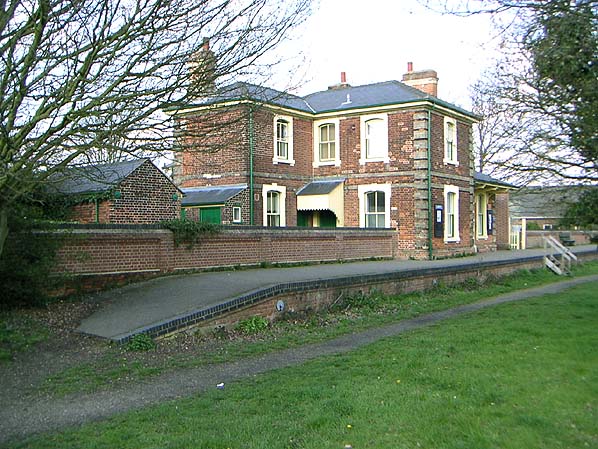
19.jpg)
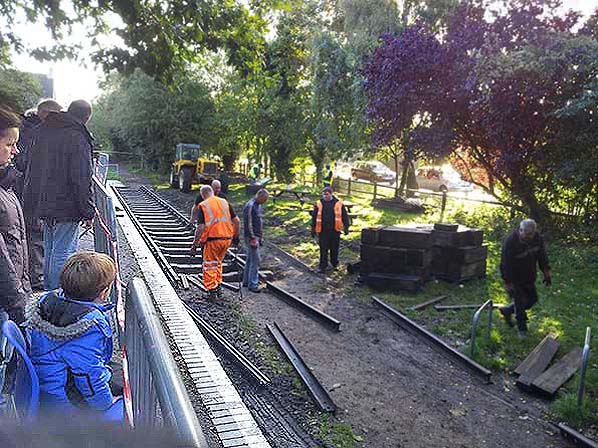
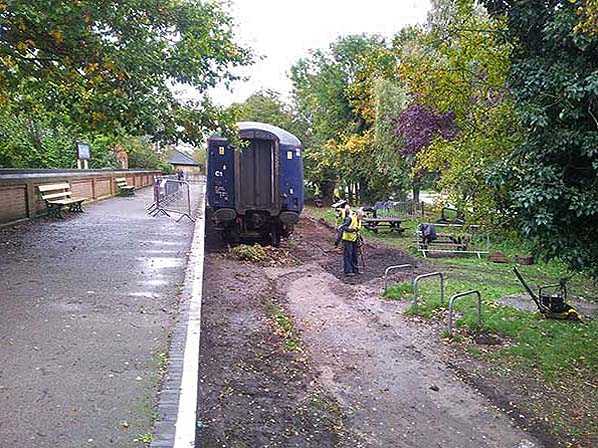
 Home Page
Home Page  Rayne Station was restored in 1994 and converted to a visitor centre with toilets a small exhibition and the working base for the Essex County Park Rangers
who maintain the
Rayne Station was restored in 1994 and converted to a visitor centre with toilets a small exhibition and the working base for the Essex County Park Rangers
who maintain the 
 In 1859 an unexpected proposal was submitted to Eastern Counties
Railway by a group of Hertfordshire businessmen who were anxious
to obtain easy transport for malt and barley from towns and villages
in West Essex. Their proposal was for a railway line, 18 miles long, linking
the towns of Bishop's Stortford, Dunmow and Braintree. They readily
agreed to the proposal, offering to have the route surveyed and
donating £40,000 to help with construction. The application
was put to parliament and permission was given for the branch
line to go ahead.
In 1859 an unexpected proposal was submitted to Eastern Counties
Railway by a group of Hertfordshire businessmen who were anxious
to obtain easy transport for malt and barley from towns and villages
in West Essex. Their proposal was for a railway line, 18 miles long, linking
the towns of Bishop's Stortford, Dunmow and Braintree. They readily
agreed to the proposal, offering to have the route surveyed and
donating £40,000 to help with construction. The application
was put to parliament and permission was given for the branch
line to go ahead.  With hindsight, it is now apparent that the branch line was never
going to succeed as a profit making passenger service. The branch
line's saviour came in the 1880s. The sudden demand for agricultural
produce in London combined with new industries that were starting
up in Braintree, both required a freight service and it was this
that was to provide important revenue for the railway. Freight
traffic continued to grow, especially at the Braintree end of
the line, but by the end of the 19th century passenger traffic
to Bishop's Stortford remained light.
With hindsight, it is now apparent that the branch line was never
going to succeed as a profit making passenger service. The branch
line's saviour came in the 1880s. The sudden demand for agricultural
produce in London combined with new industries that were starting
up in Braintree, both required a freight service and it was this
that was to provide important revenue for the railway. Freight
traffic continued to grow, especially at the Braintree end of
the line, but by the end of the 19th century passenger traffic
to Bishop's Stortford remained light.
 By the end of 1971 all freight traffic had ceased, and on 27
July 1972 a final enthusiast's trip ran from Bishop's Stortford
to Easton Lodge and back. By the autumn of that year most of the
track had been taken up, apart from the last mile out of Bishop's
Stortford. British Rail were considering the possible role this
section of line might play in carrying additional traffic to a
growing Stansted Airport, but proposals came to nothing and in
1974 the remaining track was removed.
By the end of 1971 all freight traffic had ceased, and on 27
July 1972 a final enthusiast's trip ran from Bishop's Stortford
to Easton Lodge and back. By the autumn of that year most of the
track had been taken up, apart from the last mile out of Bishop's
Stortford. British Rail were considering the possible role this
section of line might play in carrying additional traffic to a
growing Stansted Airport, but proposals came to nothing and in
1974 the remaining track was removed.